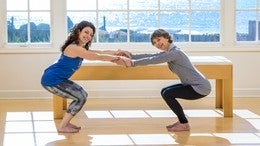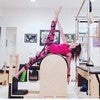Description
About This Video
Transcript
Read Full Transcript
Hello, I'm Rebekah Rothstein, and I'm here again with my buddy Ruth Alpert, to do yet another squat tutorial. Last year, we talked about the squats as essential to basically everything, everything in function and everyday life. And we were looking at how everybody needs to be able to squat to get up and down from the toilet seat, to get up and down from a chair, to get up and down from a seat on the bus, in and out of a car, and we were look at squats in a different manner. So we were looking at the basis and the biomechanics of the squat, if you're going to sit down into a seat, essentially. Now we're gonna take the squats into another dimension.
We're gonna look at squatting in a more primal approach. So ways that unfortunately, we don't really ever see adults doing, we see children doing, in western culture. Where you do see it is in non-western cultures, in more tribal societies or even in squatter toilets in other parts of the world. This is one of the best things that you can do for your hips and I also have a little personal anecdote to share which is that I've had problems with my right hip for many, many years, and over the past year, as I've been doing these very, very deep squats, it has resolved a tremendous amount of the problems, or a tremendous number of the problems that are related to the lumbopelvic hip complex that I have. So I'm a huge believer in these.
So Ruth here is going to demonstrate for us a little bit about what it would look like, and we'll do it without the block first, but if I asked you to just separate your feet a little bit and just could you squat all the way down to the ground? So she's really a perfect example of how the squat can operate and should operate, but if we were to ask her how she's able to do that, we would find out very interestingly, it's because she's been practicing this for many, many years. She's also had a lot of training and body work that has been related to this type of squat. Most of us don't. So how do you get people into this position?
One of the things that I love to do, and I'm gonna do this for myself, because I'm gonna show you now what it looks like for me to squat down. Now I couldn't do this before. This is me with a lot of training as well, certainly not the extent of Ruth. So Ruth, why don't you come and give a comparison, so that we can see what both of us look like together? So let's do it simultaneously.
(laughing) (Ruth humming a jaunty tune) It's not a competition, because I will definitely lose this one, but we're gonna squat back. Do you notice the difference between the two of us? Ruth is able to get a lot lower, her knees are able to be much closer. I, you can't necessarily tell, but I've a lot of tension in the front of my shins. I can do this, and I do this regularly, but it's still not totally comfortable.
So for somebody like myself, I have a couple options. One is if it's, even if it's too restricted, I could just sit on this yoga block, and this is what I used to do, before I could even get down to the position I'm in right now. So that I would get the stretch through the adductor area here, but I didn't have so much tension yet through the shins. And then I can even lower it one further, and then I can shift my weight forward, and sometimes I push out through the knees here, to get a little bit more of the stretch and the release. So using the block is really really useful.
Another option, though, is for people like myself. Here, I have a feeling, it also comes back to the dorsiflexion of the ankle. I'm really restricted in my dorsiflexion. Now how about you? If you were, I have a feeling that Ruth has a much greater range of motion here than I do.
Yeah, you do, actually. So her ability to get that ankle dorsiflexion is far better than mine. What I could do, to give myself a little assistance, this is a bit high for me, but I could elevate my heels, which then reduces the angle of motion there, at the ankle joint, and now, ah, this is so much easier for me. And you may be able to see the side view here of what's going on through my back. Naturally, there will be a little bit of a posterior tilt, and there will be some counter, I guess you would say some counternutation that would be going on through the sacrum at this point in time in the depth of the squat.
In other words, you're not going to maintain a quote, "neutral pelvis." That's not natural, and it's not possible. You get down to about right here, and then you start to see, or experience the change. So yes, it's hip flexion, for sure, and you're in a neutral position, but then I wouldn't be able to tell you the exact degree, but then you'll start to notice that you lose that, and that has to happen. So there's a drop, and a nice stretch that occurs, as well, and we were talking about this in the mat class today. How you will be able to get that traction between the upper part of the sacrum, so a traction that occurs between right here and I would say throughout the rest of the lumbar spine.
And you're gonna enjoy that feeling and that sensation of space that's right here. So why don't we squat together, and we can just angle inward here? Well, actually, yeah, we'll angle inward here. Now yours is gonna be more comfortable than mine. I find that I often have to just lift my heels, if I don't have something to rest my heels on, and for right now, that's also okay for me.
I could go back, and I can stay here, but it's a little bit restricted for me. So I'm gonna keep my heels slightly lifted. Let's now add in to see what we could accomplish with this. First of all, I usually will have, I'll have my clients just hang out in this position. Next, though, let's see what would happen if we shifted our weight to one side, so we tip to one side, and then tip to the other side.
Yes. And tip to one side, and tip to the other side, and now let's go to the first side, and let's walk our hands over. Yep, so we have one hand to the side, and we're gonna lift this arm up, and we're gonna lower it, and try the other side. And lift the arm up and down, and swing up, exhale down. Swing up, exhale down.
Once more. Swing up, exhale down. Swing up, exhale down. Now pause. Lowering your heels, if they weren't already lowered, bring your hands together, clasping them, and you're gonna push outward with your elbows, and try and lift your collarbone at the same time.
So in other words, you're going to lose the lumbar curve in your spine, but you're going to gain the thoracic arch, or you're going to remove the natural kyphosis in the thoracic spine, and extend, and relax. And extend. Push your hands together, and relax, and push. So you might feel a lot of stretch around the adductor area in the fascia there. And once more.
(breathing deeply) And now allow yourself to totally release, and shift your weight forward. And back. And shift your weight forward, and back, and this is something that you would build up to. You might not get to this point early on, but this is more of a goal, and it's part of why we call it a practice. And back.
And now see if you feel a little bit more release around the sacrum. Just by hanging here for a little bit, and allowing some of the movement, and we kinda see what happens if we get a little bit of rotation as well. (taking deep breaths) And then we'll place our hands down, shift the weight forward, and then if you really wanna do a yoga crow pose, you could, but we won't, but push your elbows into, yep, into your triceps, and if we wanted to, this is where we would come into a yoga crow. That made no sense, you're right. Push your knees into your triceps.
Thank you. (laughing) Yeah, I teach anatomy, right? And you're gonna lower your heels. Now maintain that curve through the lumbar, and just simply push yourself up into a standing position. And let's just move our hips side to side, and circle around.
And this is essentially what needs to happen for this wonderful mobility for function in the hips, except we lose it as we get older, and you know, it's so fun spending time around little kids, because you see them do this all the time. They just hang out here, and then they come up, and at what point in our lives do we lose that natural ability to do one of the most basic human functions, to squat, and to squat in what many people think is such an extreme, but is actually is extremely healthy for the joints, and the joints need this kind of compression, and as long as we can build up to this, it's not something to necessarily dive right into, again, it's part of our practice. So thanks for joining us in our review, as well as our expansion of discussion of squats.
Comments
I think another point as teacher's is noticing how we're standing when we teach or talk, these can lead to imbalances in the hip as well and something we can teach our clients and make them aware of. For example Ruth always stands with her legs in a neutral position with the weight evenly transferred as opposed to many of us that stand in a dancer's fourth position (usually with the same leg in front) or we constantly transfer our weight onto one leg. Makes a difference.
Thanks for the video ;)

You need to be a subscriber to post a comment.
Please Log In or Create an Account to start your free trial.


















